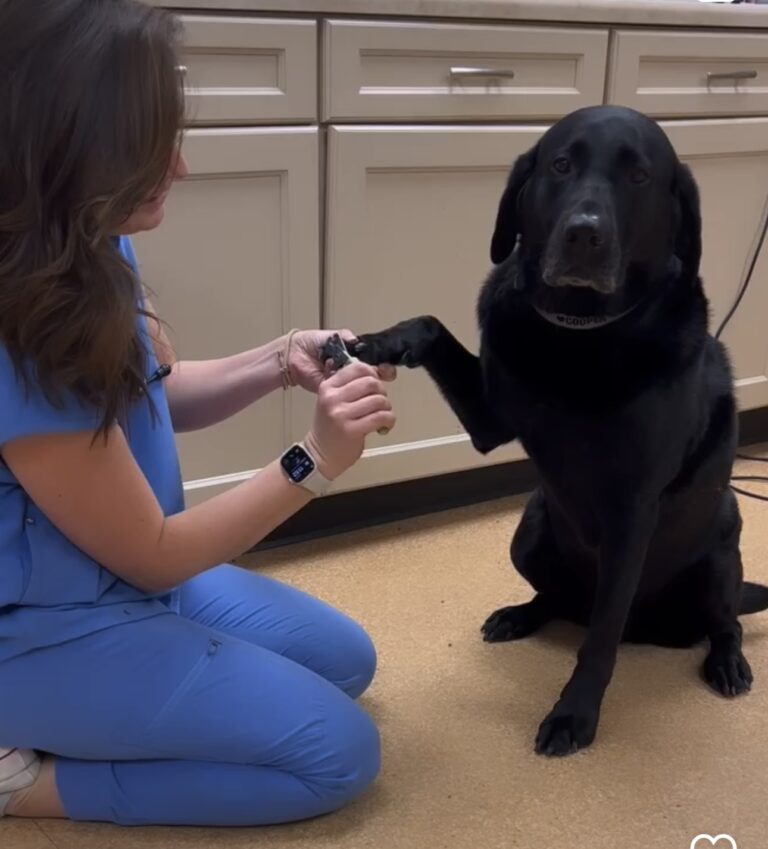Understand the Signs and Symptoms of Neurological Problems in Labradors
Neurological problems in Labradors can be serious and difficult to diagnose. Therefore, it is important to know what signs and symptoms to look for in your Labrador so that you can get them the help they need quickly. It’s heartbreaking to see my pup struggle with these conditions, but educating myself and taking steps to manage their symptoms is important.
So, I researched this topic and will share about neurological problems in labradors, how to recognize the signs and symptoms, and what to do when you suspect your dog has one. Read on to learn more!
Overview of Neurological Problems in Labradors
Neurological problems in Labradors can range from mild to severe and can be caused by various underlying factors. Below are the most common neurological disease in Labradors and their signs and symptoms.
👉Cerebellar Degeneration
Cerebellar Degeneration affects the balance and coordination of your Labrador retriever, making them shaky and wobbly. This genetic disease is progressive and worsens over time. Unfortunately, there is no cure for cerebellar Degeneration at present, but early diagnosis and treatment can slow down its progression, giving your pup the best possible life. Symptoms include tremors, wobbling gait, and stumbling. You may also notice that your pup can’t control its head and eye movements. Diagnosis involves blood tests, genetic testing, MRIs, and CT scans. Management includes physical therapy, a balanced diet, and potential medications.
👉Wobbler’s Syndrome
Wobbler’s Syndrome is a condition caused by abnormal growth in the neck vertebrae, resulting in compression of the spinal cord. This issue causes a wobbly gait and instability in the hind legs. Labrador retrievers are prone to Wobbler’s Syndrome due to their large necks and fast growth. Symptoms include wobbly gait, weakness in the hind legs, and difficulty standing. Diagnosis is made through X-rays, CT scans, and MRIs. The treatment options for Wobbler’s Syndrome include surgery, physical therapy, and medication. Prevention includes ensuring a proper diet, a controlled growth rate during puppyhood, and regular exercise to maintain neck and spine muscle density.
👉Vestibular Disease
It is a common neurological disease that affects Labradors. This disease affects the dog’s balance and is often known as Idiopathic Vestibular Disease. The sudden onset of this problem triggers your Labrador’s eyes to vibrate uncontrollably, and they may lose their balance. Symptoms include disorientation, vomiting, and rolling over continuously. It can last anywhere from a few days to a month with complete recovery. Diagnosis is made through a clinical examination, neurological exam, and blood tests. There is no specific treatment for this disease, but supportive care like anti-nausea medication is given to help your dog feel more comfortable.
👉Degenerative Myelopathy (DM)
Degenerative Myelopathy is a progressive neurological disorder affecting dogs’ spinal cord. This disorder is more common in older dogs and is a genetic condition that can be inherited. The disease is caused by the loss of myelin, a sheath surrounding nerve fibers in the spinal cord. Over time, affected dogs will experience hindlimb paralysis, and they may lose control of their bladder and bowel. As the disease progresses, your dog’s front legs weaken. If you suspect that your Labrador has DM, consult your veterinarian immediately. The vet must perform a neurologic examination and run diagnostic tests like an MRI to diagnose the condition.
👉Intervertebral Disc Disease (IVDD)
Intervertebral Disease is a canine neurological disorder that affects the spinal column. This condition occurs when the cushion-like discs between spinal bones rupture, causing pressure on the spinal nerves and spinal cord. If left untreated, the pressure can lead to permanent paralysis. This disorder is commonly seen in overweight and older Labradors. Signs that your dog may have IVDD include unusual posture, lameness, loss of bladder control, and reluctance to move. If you suspect your dog is showing signs of IVDD, consult your veterinarian. Treatment options include medications, physical therapy, and surgery.
👉Parkinson’s Disease
Although Parkinson’s disease is more common in humans, it’s possible for dogs, including Labradors, to develop this neurological disorder. Parkinson’s disease occurs when the cells that produce dopamine, a neurotransmitter, are lost or damaged. The lack of dopamine in the brain causes abnormal movements and tremors. In Labradors, Parkinson’s Disease is rare, and the cause is usually idiopathic. Signs that your dog may have Parkinson’s Disease include tremors, difficulty standing, and abnormal gait. If you suspect that your dog has Parkinson’s Disease, consult your veterinarian for a diagnosis and treatment options.
👉Inherited Polyneuropathy
Inherited Polyneuropathy is a hereditary condition affecting Labradors’ nerves and muscles. It affects both males and females and usually manifests early in life, between 3 to 4 months of age. The symptoms of Inherited Polyneuropathy include difficulty in walking or standing, tremors, and muscle weakness. While the symptoms may worsen with age, some dogs may remain asymptomatic or have mild symptoms throughout their lives. Unfortunately, there is currently no cure for Inherited Polyneuropathy and affected dogs may require lifelong treatment and management.
👉Epilepsy
Epilepsy is a chronic neurological condition that causes seizures in dogs. In Labradors, it is often inherited, and the first seizure usually occurs between 6 months to 5 years of age. The symptoms of epilepsy may vary between dogs but typically include involuntary muscle twitching, loss of consciousness, excessive drooling, and confusion. Epilepsy is a progressive disease, and seizures may become more frequent and severe as the dog gets older. Though there is no cure for epilepsy, you can effectively manage it with the help of anti-seizure medication and lifestyle changes.
These are some of the most common neurological disorders that affect Labradors. While these diseases can be serious, early detection and treatment are key to ensuring your dog’s long-term health and happiness. If you suspect that your Labrador has a neurological disorder, it is essential to consult your veterinarian as soon as possible for diagnosis and treatment options.
Neurological Problems’ Impact on Labrador’s Everyday Life
Neurological problems can significantly impact a Labrador’s everyday life in various ways. Here are some common effects:
1: Mobility and Coordination
Among the most common issues that arise from neurological problems in Labradors is a lack of mobility and coordination. This can result in difficulty walking or running, falling over, or even collapsing. Watching your furry best friend struggle with something that we often take for granted can be heartbreaking. As a result of these issues, dogs may become less active or even have a loss of interest in physical activities. They may also require specialized equipment, such as slings or braces, to assist with movement.
2: Muscle Weakness
Neurological problems can also cause muscle weakness; without strength, your Lab may struggle with regular activities. Some common symptoms of muscle weakness include limping, unsteady gait, difficulty jumping, and even incontinence. It may cause difficulty getting up from a sitting position, leading to longer recovery after exercise, surgery, or physical activity. It can be frustrating for both the owner and the dog as you watch them become weaker and yearn to see them happy and healthy again.
3: Sensory Disturbances
It can result in difficulty seeing or hearing or even a dullness in other senses. Reduced vision or hearing can impact a dog’s ability to interact with the world around them and may lead to separation anxiety. Weight shifts are another challenge faced by Labradors with sensory disturbances; they may alter their spine and posture leading to back pain, muscle weakness, and even arthritis. Thus, your lab might have difficulties in normal activities of daily living.
4: Cognitive Dysfunction
Neurological damage can impair a dog’s memory, recognition ability, and overall awareness of its surroundings. They may become disoriented or confused, find it difficult to navigate their familiar environments, and struggle with simple commands. They may also display personality changes, such as becoming more withdrawn or irritable.
5: Reduced Energy Level
If your usually energetic Lab shows decreased energy, it could indicate neurological problems. These dogs may appear lethargic, unwilling to participate in their usual activities, or even refuse to get up. They can also struggle with balance, coordination, and muscle control, making running, jumping, and playing harder. Fortunately, there are ways to help your dog adjust to their changing capabilities and maintain a good quality of life.
6: Incontinence
Dogs who struggle with neurological damage are often prone to incontinence, particularly as they age. It can make it challenging to keep them clean, comfortable, and free from infections. In some cases, you can manage incontinence with medication or changes to their diet, but in more severe cases, it may be necessary to adjust your home environment to help your dog cope.
7: Pain and Discomfort
A neurological problem can cause chronic pain, which may discourage your Labrador from participating in their usual activities. They might prefer to rest rather than move around and become less social. In extreme cases, this pain can lead to depression, so it’s important to be aware of any changes in your dog’s behavior and seek help from your veterinarian if necessary.
8: Appetite and Eating
A loss of appetite can occur due to pain and discomfort or because their sense of smell and taste has been impaired. It can be particularly concerning for young labradors or those needing weight gain. Sometimes, neurological issues can cause difficulty in swallowing or pain when eating, leading to weight loss and nutritional deficiencies that can harm the dog’s overall health.
9: Interaction and Socialization
Labradors are known for their friendly nature, so it can be concerning when a neurological issue affects their ability to interact with humans and other animals. For instance, a dog who experiences difficulty with its vision or balance may become more risk-averse, making them shy away from social interaction. This can also be a sign of the fear they feel due to pain or discomfort. As a result, they may become aggressive towards people and other dogs, leading to social isolation.
10: Behavior Changes
In addition to the above, neurological problems can also affect a labrador’s personality and behavior. For instance, they may become more irritable, anxious, or depressed, making them less responsive to their owner’s commands or routines. They may also develop unexplained fears, phobias, or seizures, leading to more stress for the dog and its owner.
It can be heart-wrenching to watch your beloved dog suffer, but as the owner, there is much you can do to help them. If you suspect your Labrador is experiencing neurological issues, contact your veterinarian for guidance.
Building a Good Home Environment for Labradors With Neurological Problems
If you’re living with a Labrador diagnosed with a neurological problem, there are some steps you can take to create a safe and comfortable home environment.
✔️Consider Your Home Layout
The first step in building a good home environment for your Labrador Retriever is to consider the layout of your home. If your Labrador has mobility problems, you’ll want to ensure that they have access to areas of the home that are easy to navigate. Consider removing tripping hazards, such as area rugs or electrical cords, that can cause injury to your pet. Creating a safe and comfortable resting area where your Labrador can rest and sleep undisturbed is also essential. Consider getting a well-cushioned bed or crate that’s comfortable for your pet.
✔️Create a Consistent Routine
Labradors with neurological problems can become stressed and anxious if the routine is disrupted. Therefore, creating a consistent routine that your Labrador can rely on is essential. It’s critical to establish a schedule for meals, walks, and playtime that’s consistent. A consistent routine will help your Labrador feel safe and secure, which is essential in managing their condition.
✔️Provide Plenty of Exercises
Exercise is essential for Labradors with neurological problems. It helps keep the muscles and joints healthy and promotes mental stimulation. Consider providing your Labrador with 30 minutes to an hour of physical activity each day, depending on their level of mobility. It’s essential to choose low-impact exercises that don’t put too much pressure on their joints. Swimming, slow walks, or gentle games of fetch can be good forms of exercise for Labradors with mobility problems.
✔️Consider a Specialized Diet
A specialized diet can help to manage the condition of Labradors with neurological problems. Dietary changes can help to manage seizures or mobility problems in your pet. Speak to your veterinarian to determine if a specialized diet is recommended for your dog’s condition. You should only make dietary changes under the guidance of a veterinarian.
✔️Invest in Enrichment Toys
Enrichment toys help to provide mental stimulation for Labradors with neurological problems. Consider investing in a puzzle or chew toys that can stimulate your pet mentally. These toys help reduce stress and boredom and promote natural instincts such as chewing and problem-solving.
✔️Seek Professional Help
If you struggle to care for your pet with neurological problems, seek professional help. Consult a veterinarian or a veterinary behaviorist who can provide a comprehensive care plan. They can guide you on the right diet, medication, and treatment options for your furry friend. Join a community of pet owners going through similar experiences, and learn from their experiences. It’s essential to stay informed and educated about your pet’s condition to provide the best care possible.
Frequently Asked Questions
Q: Can neurological problems in Labradors be treated or managed?
The answer is, in many cases, yes. Many treatments are available for neurological problems in Labradors, including medication, surgery, and physical therapy. However, the success rate of these treatments can depend on the severity and complexity of the issue. If you suspect your Labrador has a neurological problem, seeking immediate veterinary help is vital to ensure the best possible outcome.
Q: Can environmental factors contribute to neurological problems in Labradors?
Yes, they can. Labradors exposed to environmental toxins or radiation may develop neurological problems. However, genetics play a more significant role in developing neurological issues in dogs. Preventing exposure to environmental toxins is crucial to your Labrador’s overall health. Use natural cleaning products, avoid pesticides, and protect your yard from dangerous chemicals.
Q: How long does diagnosing a Labrador’s neurological problem take?
The diagnosis of a neurological problem can vary depending on the case’s complexity. Some issues may be diagnosed quickly, while others may require various tests, including MRI scans, X-rays, blood tests, and urine exams. Be patient, observant, and communicate with your veterinarian at every step of the diagnosis process.
Q: Can Labradors with neurological issues live a normal lifespan?
The answer to this question depends entirely on the severity of the issue. In some cases, Labradors can live a relatively normal life with neurological issues; in others, the problem can lead to debilitating, life-threatening conditions. Regardless, seeking immediate veterinary assistance and following your veterinarian’s advice is critical to providing your Labrador with the best possible quality of life.
Q: Are there any surgical interventions available for Labradors with neurological issues?
Indeed, there are. Surgery may be recommended for Labradors with neurological issues caused by a spinal cord injury or herniated disk. Surgery is usually a last resort due to its complexity and potential risks. Your veterinarian will only recommend surgery if it will likely improve your Labrador’s condition.
Final Words
After diving into the research on neurological problems in labradors, my heart breaks for these furry friends and their devoted owners. It’s tragic to think that something as seemingly innocuous as genetics can lead to a lifetime of suffering for these loyal companions. It’s clear that more work needs to be done to understand these neurological conditions and prevent them from occurring in the first place.
But in the meantime, we must provide our labradors with the love and care they need to ensure their quality of life. As dog owners, it’s our responsibility to advocate for their health and wellness – and that starts with educating ourselves about common health issues, like neurological problems in labradors. Together, we can make a difference in the lives of these precious pups.









